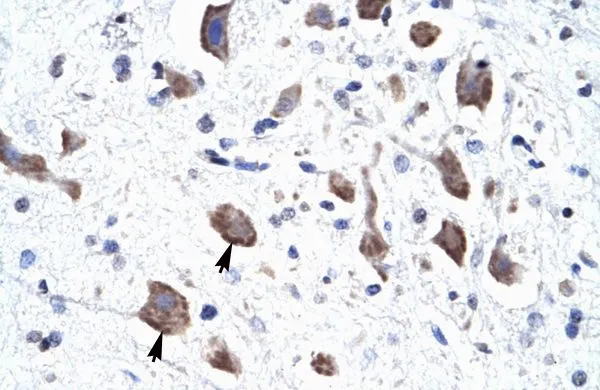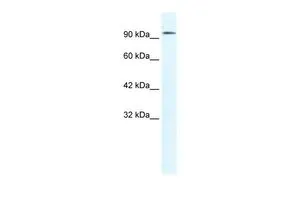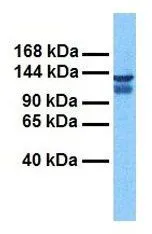
IHC-P analysis of human brain tissue using GTX47617 CLCN3 antibody at 4.0-8.0microg/ml.
CLCN3 antibody, C-term
GTX47617
ApplicationsWestern Blot, ImmunoHistoChemistry, ImmunoHistoChemistry Paraffin
Product group Antibodies
ReactivityHuman
TargetCLCN3
Overview
- SupplierGeneTex
- Product NameCLCN3 antibody, C-term
- Delivery Days Customer9
- Application Supplier NoteWB: 0.2-2.5 ug/ml. IHC-P: 2-10 ug/ml. *Optimal dilutions/concentrations should be determined by the researcher.Not tested in other applications.
- ApplicationsWestern Blot, ImmunoHistoChemistry, ImmunoHistoChemistry Paraffin
- CertificationResearch Use Only
- ClonalityPolyclonal
- Concentration0.5-1 mg/ml
- ConjugateUnconjugated
- Gene ID1182
- Target nameCLCN3
- Target descriptionchloride voltage-gated channel 3
- Target synonymschloride channel 3; chloride channel protein 3; chloride channel, voltage-sensitive 3; chloride transporter ClC-3; CLC3; ClC-3; H(+)/Cl(-) exchange transporter 3; NEDHYBA; NEDSBA
- HostRabbit
- IsotypeIgG
- Protein IDP51790
- Protein NameH(+)/Cl(-) exchange transporter 3
- Scientific DescriptionThis gene encodes a member of the voltage-gated chloride channel (ClC) family. The encoded protein is present in all cell types and localized in plasma membranes and in intracellular vesicles. It is a multi-pass membrane protein which contains a ClC domain and two additional C-terminal CBS (cystathionine beta-synthase) domains. The ClC domain catalyzes the selective flow of Cl- ions across cell membranes, and the CBS domain may have a regulatory function. This protein plays a role in both acidification and transmitter loading of GABAergic synaptic vesicles, and in smooth muscle cell activation and neointima formation. This protein is required for lysophosphatidic acid (LPA)-activated Cl- current activity and fibroblast-to-myofibroblast differentiation. The protein activity is regulated by Ca(2+)/calmodulin-dependent protein kinase II (CaMKII) in glioma cells. Multiple alternatively spliced transcript variants encoding different isoforms have been identified. [provided by RefSeq, Aug 2011]
- ReactivityHuman
- Storage Instruction-20°C or -80°C,2°C to 8°C
- UNSPSC12352203


